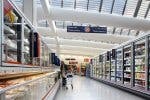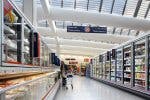The result is an energy saving of 75% per freezer. Philips says that, per freezer, the annual energy savings are estimated to be the same as the entire six months electricity bill of an average household (see Footnote). These savings also equate to more than 1 tonne of CO2 per freezer per year, which contributes in the fight against climate change.
However, the Affinium LED solution also ensures good quality of light which is of course particularly important in the retail environment where merchandise has to be displayed to optimum effect attracting shoppers when making their purchase decisions. Furthermore, good consistent uniformity of light gives a much more professional appearance to the freezer display in line with brand values and company image.
Working on the 3-year development project to find improved freezer lighting solutions, team member Les Cole, explains, “As a leading retailer, Sainsbury’s is committed to bringing its customers the best in food and health – that also means how they are presented. At the same time we need to respect the environment. At Sainsbury’s we launch new projects every year designed to achieve lower energy consumption. We were, therefore, particularly interested in the Affinium LED solution as it combined both of these important elements – light quality and energy reduction.”
The Affinium LED modules use Luxeon Rebel LEDs, and each module is expected to have a useful life of up to 10 years in store. This compares with fluorescent lamps that have a useful life of just 6 -12 months when used in the hostile environment of freezers. Thus, Sainsbury’s can dramatically reduce maintenance costs across their estate.
In addition, LED lighting is inherently more reliable and more rugged than fluorescent lamps. What is more, since it operates far better at lower temperatures and produces less heat, cooling costs are reduced.
Frozen foods are also no longer exposed to glass fragments where instances of fluorescent lamp breakages have sometimes occurred inside the freezer. In fact, enhanced safety is a prime feature of LED lighting as it operates at an SELV (Safety Extra Low Voltage) of 24V DC, replacing 240V in many traditional cabinets. This means that in the unlikely circumstance that a LED module should break down or electrical wiring be exposed, the voltages used in the freezer are inherently safe for customers under all circumstances.
The new Affinium LED freezer lighting system has been designated a Philips “Green Flagship” product, all of which have been independently measured as the best environmental choice in their category available in the market today.
Footnote
Source is Eurostat. Calculation is based on 5-door freezers. Typically 80W/door fluorescent lighting is replaced with on average 20W of LED lighting, thus reducing the input power of a 5-door freezer from lighting from 400W to 104W. The lamps are ON for 100 hours per week, thus consuming (400-104)*100 *52 = 1.5kWh. The additional savings are as a result of the fact that if heat is not put INTO the freezer, the condensor needs to work less hard to extract it.






